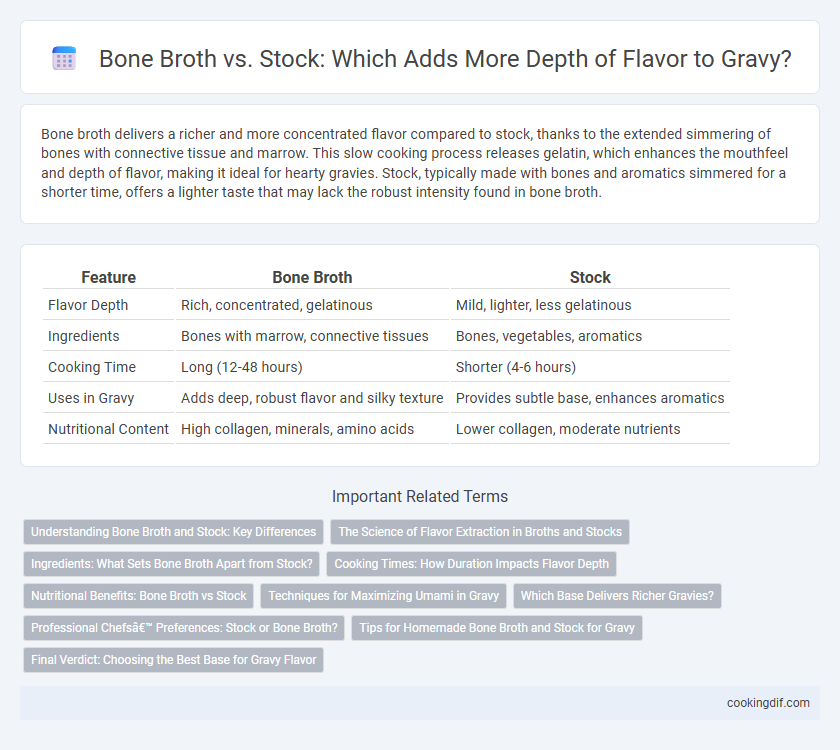Bone broth delivers a richer and more concentrated flavor compared to stock, thanks to the extended simmering of bones with connective tissue and marrow. This slow cooking process releases gelatin, which enhances the mouthfeel and depth of flavor, making it ideal for hearty gravies. Stock, typically made with bones and aromatics simmered for a shorter time, offers a lighter taste that may lack the robust intensity found in bone broth.
Table of Comparison
| Feature | Bone Broth | Stock |
|---|---|---|
| Flavor Depth | Rich, concentrated, gelatinous | Mild, lighter, less gelatinous |
| Ingredients | Bones with marrow, connective tissues | Bones, vegetables, aromatics |
| Cooking Time | Long (12-48 hours) | Shorter (4-6 hours) |
| Uses in Gravy | Adds deep, robust flavor and silky texture | Provides subtle base, enhances aromatics |
| Nutritional Content | High collagen, minerals, amino acids | Lower collagen, moderate nutrients |
Understanding Bone Broth and Stock: Key Differences
Bone broth and stock differ primarily in cooking time and ingredient composition, affecting their depth of flavor and nutritional profile. Bone broth simmers for 12-24 hours, extracting collagen, amino acids, and minerals which create a rich, gelatinous texture and intense taste. In contrast, stock cooks for 4-6 hours with bones and aromatics, delivering a lighter, more subtle flavor ideal for foundational cooking.
The Science of Flavor Extraction in Broths and Stocks
Bone broth and stock differ primarily in cooking time and ingredient concentration, impacting their flavor profiles through the science of flavor extraction. Extended simmering in bone broth breaks down collagen into gelatin and releases amino acids, enhancing umami richness and mouthfeel, while stock extraction emphasizes connective tissue and marrow flavors from bones for a cleaner, lighter taste. The Maillard reaction and extraction of minerals and gelatin during slow simmering elevate the depth of flavor, with broth achieving greater complexity and body compared to stock.
Ingredients: What Sets Bone Broth Apart from Stock?
Bone broth stands out from stock due to its key ingredients and cooking process, primarily involving long-simmered bones with connective tissues and marrow, which release collagen and rich minerals, enhancing depth of flavor and creating a gelatinous texture. Stock typically uses a blend of bones, meat, and vegetables, simmered for a shorter period, resulting in a lighter body and less concentrated flavor. The presence of collagen in bone broth not only enriches taste but also provides health benefits, making it a nutrient-dense foundation for gravies and soups.
Cooking Times: How Duration Impacts Flavor Depth
Bone broth, simmered for 12 to 48 hours, extracts collagen and minerals, resulting in a richer, more gelatinous texture that enhances gravy depth of flavor. Stock, cooked for 4 to 6 hours, offers a lighter, cleaner taste with less body due to shorter cooking time. Prolonged simmering in bone broth intensifies savory complexity, making it ideal for gravies needing profound umami and mouthfeel.
Nutritional Benefits: Bone Broth vs Stock
Bone broth offers superior nutritional benefits compared to stock due to its higher collagen, amino acids, and mineral content derived from simmering bones and connective tissues for extended periods. Stock typically provides a lighter flavor profile with fewer nutrients because it is made primarily from simmering bones and vegetables briefly without gelatin extraction. These differences make bone broth a more nutrient-dense base for gravies, enhancing both taste complexity and health benefits.
Techniques for Maximizing Umami in Gravy
Bone broth offers a richer umami profile than traditional stock due to its prolonged simmering of bones with marrow, collagen, and connective tissues that release glutamates and amino acids essential for depth of flavor. Techniques for maximizing umami in gravy include roasting bones and vegetables beforehand to develop Maillard reactions, deglazing the pan with wine or vinegar to capture fond, and reducing the liquid slowly to concentrate savory compounds. Incorporating ingredients such as dried mushrooms, miso, or tomato paste further enhances umami complexity, creating a robust and flavorful gravy.
Which Base Delivers Richer Gravies?
Bone broth delivers richer gravies compared to stock due to its prolonged simmering process that extracts collagen, minerals, and amino acids from bones, resulting in a deep, gelatinous texture and intense flavor. Stock, typically made with shorter cooking times and more vegetables, offers a lighter, less concentrated taste that can serve as a subtle base but lacks the umami depth of bone broth. For gravies aiming to achieve bold, savory richness and enhanced mouthfeel, bone broth is the superior foundational ingredient.
Professional Chefs’ Preferences: Stock or Bone Broth?
Professional chefs often prefer bone broth over traditional stock for its richer depth of flavor and higher collagen content, which adds a velvety texture to gravies and sauces. Bone broth simmers longer, extracting minerals and gelatin that enhance mouthfeel and complexity, making it ideal for dishes requiring a robust, savory backbone. While classic stock offers a cleaner, more neutral base, bone broth's intensified profile aligns with chefs' desires for layered, umami-rich gravies.
Tips for Homemade Bone Broth and Stock for Gravy
Homemade bone broth enhances gravy with rich, gelatinous depth by simmering marrow-rich bones for 12-24 hours, extracting collagen and minerals that create a silky texture. Stock offers a lighter base by using a shorter simmer time of 4-6 hours and more vegetables, providing a balanced flavor without overpowering. Straining both carefully and reducing them to concentrate flavors ensures an intensely savory gravy perfect for complementing roasted dishes.
Final Verdict: Choosing the Best Base for Gravy Flavor
Bone broth delivers a richer, more robust flavor due to its extended simmering time and nutrient extraction, making it ideal for deeply savory gravies. Stock offers a lighter, cleaner taste with gelatin that enhances texture but lacks the intense umami found in bone broth. For gravies requiring maximum depth and complexity, bone broth stands out as the superior base choice.
Bone broth vs Stock for depth of flavor Infographic

 cookingdif.com
cookingdif.com